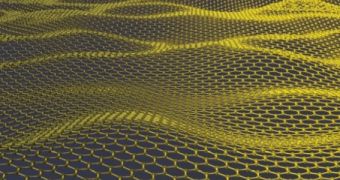A group of investigators at the University of Cincinnati, led by materials engineering PhD student Fei Yu, is currently looking into how graphene could be introduced in new generations of solar cells and panels. This material could contribute to both improved performances and extra resilience to damage.
The team has already reported early results of their study. Researchers say that solar panels can be manufactured at lower costs by introducing graphene in the production process. At the same time, the resulting cells are more efficient in terms of light conversion and show improved flexibility.
Solar cells that are more flexible do not break as often as their predecessors, not even when dropped from an average height. This could translate into significant savings for home owners who use solar-powered lamps in their gardens, for example, and are well-acquainted with the costs associated with replacing a lighting device they accidentally bump into.
However, more important than the economic aspect is the significant power conversion boost that polymer solar cells display once they are treated with nanoscale flakes (nanoflakes) of graphene. Details on these improvements were revealed at the American Physical Society (APS) meeting in Denver, on March 3, 2014.
Yu's work is centered on polymer-blend bulk-heterojunction (BHJ) solar cells, to which he added minute amounts of graphene nanoflakes. “There has been a lot of study on how to make plastic solar cells more efficient, so they can take the place of silicon solar cells in the future,” he explained.
“They can be made into thinner, lighter and more flexible panels. However, they’re currently not as efficient as silicon solar cells, so we’re examining how to increase that efficiency,” the expert said.
Polymers have a number of advantages over other materials commonly used in solar cells. For starters, they are based on carbon, rather than silicon, which provides them extra strength right off the bat. They are also more flexible and durable and can transport charges through their bodies more effectively.
This is especially true for graphene, which is a 2D compound made up entirely out of pure carbon. As such, its charge conductivity is very high. “We want to maximize the energy being absorbed by the solar cell, so we are increasing the ratio of the donor to acceptor and we’re using a very low fraction of graphene to achieve that,” Yu explained.
The researcher and his team now plan to focus their efforts on understanding how the physics of the new class of devices work. Additional studies will be conducted to determine the best film morphology for these cells, as well as to figure out how to best distribute the graphene nanoflakes through the polymer, in order to boost efficiency even more.
“The increased performance, although well below the highest efficiency achieved in organic photovoltaic (OPV) devices, is nevertheless significant in indicating that pristine graphene can be used as a charge transporter,” Yu concluded.

 14 DAY TRIAL //
14 DAY TRIAL //